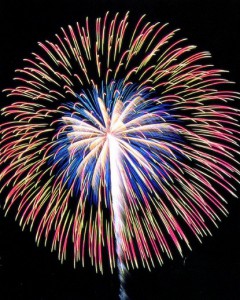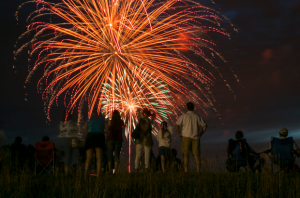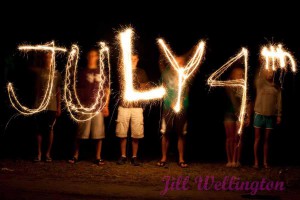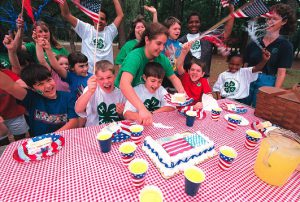by Yolanda Goode | Jul 3, 2015
 They wiz, sparkle, pop and twirl. They thrill and sometimes scare us. Do you recall the first sparkler that you got to hold? Was it an exciting, magical experience, or did you get burned? Do you really know how hot a sparkler can get? Most children are rarely concerned with safety, It is up to the adults to keep them safe. This is especially true when it comes to fireworks. We know that as the Fourth of July is approaching, many will have their own personal fireworks show. Believe it or not, over 11,000 injuries occur each year (more than half of them happen around Forth of July celebrations).
They wiz, sparkle, pop and twirl. They thrill and sometimes scare us. Do you recall the first sparkler that you got to hold? Was it an exciting, magical experience, or did you get burned? Do you really know how hot a sparkler can get? Most children are rarely concerned with safety, It is up to the adults to keep them safe. This is especially true when it comes to fireworks. We know that as the Fourth of July is approaching, many will have their own personal fireworks show. Believe it or not, over 11,000 injuries occur each year (more than half of them happen around Forth of July celebrations).
Most cities offer a free fireworks show around this time of year. I highly recommend taking in city fireworks show and foregoing a personal one. You won’t have to worry about all the logistics of a personal fireworks display. You’ll just have to worry about getting a good viewing spot and the traffic. If you are still set on setting off fireworks, keep reading.
First of all, consider the Law. Are you able to purchase and launch fireworks in your town or city? Do you know if the fireworks you have purchased are legal in Florida? Many of the fireworks sold at road side stands are not, such as firecrackers and roman candles. Setting off illegal fireworks can result in up to a year in prison and $1,000 in fines. Second, work out safety procedures ahead of time. Carefully consider these three safety areas; personal, property, and environment.Here’s a checklist to help ensure a fun but SAFE fireworks experience for friends and family (also available as a printable PDF)
Personal Safety:
- Do you have a first aid kit on hand? Sparklers can burn up to a temperature of 2,000 thousand degrees (glass melts at only 900 degrees).
- Do you have a fire extinguisher and do you know how to use it?
- Is water available to douse dud fireworks or to put out a fire? Put another adult in charge of dousing dud fireworks and to be on “spark” lookout. Have hoses and water buckets at the ready.
- Are you familiar with the fireworks you plan to shoot? Only handle fireworks you know and heed all warnings. Leave the professional (or illegal) fireworks to the permitted professionals.
- Have you refrained from alcohol? Alcohol and the handling of fireworks is not a good mix.
- How will you ignite the fireworks to protect yourself if it goes off before it should? Make sure to not place your body over a firework when you are lighting it.
- Sometimes fireworks do not go off like they should. Leave it alone for several minutes to be sure it really is a dud. Don’t try to relight it. Douse with water before disposing of it.
- Have you communicated safety ground rules to the guests (and especially the children)?
- Stay in the clearly marked safe zone
- Adults only should handle all the fireworks
- It is not recommended that children handle fireworks. If a child is given a sparkler, he should be carefully monitored at all times.
Property Safety:
- Does the launch area have a large enough radius to prevent fireworks from landing on any structures, such as a house, garage, or vehicle?
- Have you informed your neighbors? It is courteous to inform your neighbors when you plan to host an event especially one that involves fireworks.
Environmental Safety:
- Have you checked the weather? Has it been really dry in your area? Is there a temporary ban on burning? Will it be windy?
Let not your event be the cause of the story being told about how Uncle Gump lost the tip of his finger. We also don’t want to have to replace our neighbor’s grass or garage. Keep it fun while being safe and share these tips with your friends. If you would like great information on how to photograph fireworks, see our archived article on fireworks photography by Georgene Bender.
Here are some additional links on fireworks safety that you may find helpful:
Next week, Monica Brinkley will share food safety tips for your next picnic or barbeque! Your opinion matters to us- please take this short survey to provide feedback to help us improve this blog https://ufl.qualtrics.com/SE/?SID=SV_3gtLKjqia3F75QN.
by Whitney Cherry | Jul 1, 2014
Article by guest blogger, Georgene Bender (South Central Regional Specialized 4-H Agent)

Photography by David Perkiewcz,, The Cleveland Plain Dealer
Photography is a popular 4-H project and this time of year, it is fun to experiment taking pictures of fireworks and sparklers. With helpful tips you will be amazed at what you can do. Let’s review some basics. The word “photography” means drawing with light….so the key is the amount of light needed for these unique shots. Basically there are two camera types a) point & shoot and b) Digital Single-lens reflex. Each camera type has various features. It is good to familiarize yourself with them in the Menu or camera manual. What? You don’t have that book anymore. No problem – search for it online.
Focus on Infinity- Set your focus to just less than infinity (or choose a landscape setting if you can’t manually adjust focus) and use an aperture of f/8 t- f/16.
Equipment- Be sure to take a small flashlight to adjust your settings in the night and a sturdy tripod – this is the best to reduce movement and blurred photos. Another great tool for the SDLR is the cable release cord that you can control the shutter’s button or the digital remote. Digital cameras will have a setting.
Bust Shooting- Also known as ‘continuous drive’ allows you to shoot multiple shots automatically. On a DSLR go to your menu and select Self-timer and you will see two options inside. A) Self-timer delay allows you to set time after how many seconds camera should take a shot and available values are 2s, 5s, 10s, and 20s. B) Number of shots you want to take in self-timer mode. You can choose between 1 and 9 shots.
Five Top Tips:
- Observe the wind direction from where you are. Pick a location upwind so that your photos do not turn out hazy.
- Pack extra batteries and memory cards- long exposures drain battery life, and you will need to shoot lots of pictures to get a few great shots.
- Watch for the fireworks as they travel and push and hold the release button. (This will take time to practice – and also the bust shooting will help for better capture)
- Learn more online. A couple of good sources include the Walt Disney World (WDW) Photography series. There are YouTube videos by Cory Disbrow from WDW Photography.com http://youtu.be/yZh_ADUsgrY and http://wdwphotography.com.
- Practice playing with light before the fireworks by having friends ‘air write’ their name with the flashlight or sparklers. You, with your trusty tripod and camera settings shoot pictures. You will be amazed at what you get.
This chart below gives you the areas of each camera type to prepare before shooting.
|
SETTINGSMenu screen or, Bulb |
SHUTTERControls the open/close of light into camera |
ISOSensitivity of the light |
FLASHArtificial light |
APERTUREControls amount of light |
| Point and Shoot |
Manual(Check your manual as compact cameras have this as a menu optionLook for information on a delay release timer. |
Keep open for 10– 30 seconds; find your ‘night setting’ might be a half moon with starsThere is no B setting on Compact Cameras |
Lowest it will go |
OFF |
N/A |
| DSLR |
M = MANUALB= BULBTurn on noise reduction
Delay release setting |
On B setting, you can hold the camera button for as long as you want10 – 60 sec then went you release the button the shutter will close out the light. |
100 or lower |
OFF |
Changing the aperture is changing the f-stop.Set between f2.8 and f8
The lower the f-stop the more light |

Photo by Jill Wellington
Take lots of pictures this weekend– and please SHARE your best shot on our blog, Facebook, or Twitter! To learn more about the 4-H Photography Project and Contests, visit http://florida4h.org/programsandevents_/photo/photo-contest-resources/. If you have a passion for photography, consider serving as a 4-H photography project leader or becoming a sponsor of your local 4-H photography program. For more information, contact Heather Kent at hckent@ufl.edu.
Credits to:
Fleenor, S., Asdtroth, K. and Peters, C. 2010. “Catch the Spark” University of Arizona Extension 4-H Youth Development.
“How to Take Multiple Shots in Self-Timer Mode.” http://www.dailyphotographytips.net/question-answer/how-to-take-multiple-shots-in-self-timer-mode/
Harnocz, A. July 1, 2014 “How to Photography Fireworks” The Cleveland Plain Dealer. http://www.cleveland.com/interact/2014/07/how_to_photograph_fireworks_5.html
by Heather Kent | Jul 2, 2016
It’s Fourth of July weekend and time to celebrate our independence with family and friends. This week, we wanted to share with you some tips and tricks to make your celebration fun, yummy and safe! We’ve compiled a list of previous posts that you might want to reference for this weekend:

Photo by Jill Wellington
by Heather Kent | Jun 23, 2021

Photo credit: UF IFAS Photography
The 4th of July is one of my favorite holidays! Growing up it was the time that my family (even those distant cousins) gathered together for a weekend of fun, food, and fireworks. There is nothing worse than spending your holiday sick or injured, so we have complied plenty of resources to help you plan a celebration that is fun, but also keeps everyone safe:
We hope you have a fabulous 4th of July and that these tips and resources add to the fun!
 They wiz, sparkle, pop and twirl. They thrill and sometimes scare us. Do you recall the first sparkler that you got to hold? Was it an exciting, magical experience, or did you get burned? Do you really know how hot a sparkler can get? Most children are rarely concerned with safety, It is up to the adults to keep them safe. This is especially true when it comes to fireworks. We know that as the Fourth of July is approaching, many will have their own personal fireworks show. Believe it or not, over 11,000 injuries occur each year (more than half of them happen around Forth of July celebrations).
They wiz, sparkle, pop and twirl. They thrill and sometimes scare us. Do you recall the first sparkler that you got to hold? Was it an exciting, magical experience, or did you get burned? Do you really know how hot a sparkler can get? Most children are rarely concerned with safety, It is up to the adults to keep them safe. This is especially true when it comes to fireworks. We know that as the Fourth of July is approaching, many will have their own personal fireworks show. Believe it or not, over 11,000 injuries occur each year (more than half of them happen around Forth of July celebrations).


